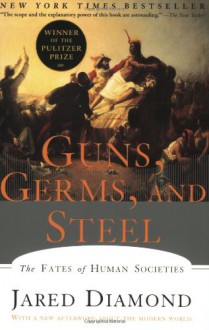
Step 1: Be born into the right environment.
Germs, Guns, and Steel attempts to answer one of the more uncomfortable questions of history: why on earth did some civilizations dominate others? Ignoring the various power-struggles that occurred within each continent, why was it the Eurasian explorers who "discovered," conquered, and destroyed so many native civilizations? For far too long, we have clung to the idea that "the white man's burden" was to be a somehow superior being to the people he tyrannized. While we've finally dispensed with that old chestnut--at least in polite conversation--the troubling question remains: given that there is no actual difference between peoples, what shaped societies to create the outcomes that we observe?
Diamond's answer is simple. (Hint: it's in the title.) In fact, his thesis can be stated even more simply: it's all down to the environment. This doesn't mean to imply that early environment actually shaped better or smarter types of people; all it means is that environments shaped societies in various ways that eventually led to conquest or capitulation. At no point did any of the events of history make one ethnicity or tribe of people actually qualitatively "better"; the environment only changed the tools available, not the peoples themselves. The book itself can get a bit dry, and I would really like to remember the theories here, so I'm going to summarize the talking points. So spoiler warning, I guess, just in case the title and what you know about history haven't given away the whole thing already.
Personally, I'm not convinced that the guns/germs/steel trifecta is actually the best summary of the environmental effects that Diamond describes. Take the case of Pizarro versus the Incan king Atahualpa: how did Pizarro's 168 men take down the Incan nation? And why wasn't Atahualpa marching on Madrid? Technological superiority was definitely a factor--Atahualpa assumed that 168 men weren't a threat because he didn't account for the armour, guns, and canon. He therefore allowed Pizarro to march unopposed to the capital. But Pizarro also got there long before Atahualpa expected because of another important factor: horses. Fast transportation gave Pizarro the mobility that improved scouting and the ability to send for recruitments. And then there's the third, and most important factor: disease. At various points in history, disease has been recognized as one of the most effective methods of warfare. This was particularly devestating in Pizarro's case, since the worst of the diseases tended to go mainly in one direction, often knocking out over 90% of the native peoples that the Europeans encountered. Colonists were more than ready to take ruthless advantage of the power of germs, but even this still leaves some nagging questions behind:
- Why did the deadly diseases tend to spread in only one direction?
- Why weren't there horse equivalents in Peru?
- Why was the fighting technology of the Spaniards superior?
- Why did Spain take the role of conqueror/explorer instead of the reverse?
The answer to all of the above is (you guessed it): environment.
One important thing to note: in my summary, I've severely simplified the structure of the book to that of Eurasia against other parts of the world. The book itself looks at a far larger variety of conquests: Māori versus Mauri, Polynesians versus other Polynesians, Incans and Aztecs versus their surrounding groups, and far more. In simplifying the examples to those of the European conquerors, I've also added a focus on European imperialism that may be a major theme, but is, I think, absent from much of the book.
The first important distinction is hunter/gatherer versus agrarian. I really like how Diamond approaches this: he explicitly states that neither lifestyle is inherently superior, and that those who remained in hunter/gatherer societies did so not because of stupidity or stubbornness, but because it made economic sense to do so. (In fact, early agrarian peoples tended to be malnourished and live shorter lives.) For agrarian societies to work, you need to have fertile land and easily cultivatable crops, and you need to be in a situation that the risk of crop failure can be weathered. Domesticated crops tend to be radically different from the wild versions, and the difference comes, of course, from genetic modification. Since none of the early peoples did much gene-splicing, this meant that early cultivatable crops tended to be ones that required only one or two mutations to become a crop variety. For example, peas only needed one mutation, while bananas, acorns, and apples were impressively difficult because they required a long chain of mutations to be edible or domesticable. Wild almonds, for example, are chock-full of cyanide, but only one mutation was required for the almond tree to stop producing poison, leading to an early distinction between domesticated and wild plants. A disproportionate number of cultivatable crops--especially the cereal crops-- turned out to be in Eurasia. This wasn't because of some superior agrarian capabilities of early European people--according to Diamond, we haven't managed to domesticate a single new crop in recent times, implying that early peoples were darned good at domestication. More importantly, the entire setup of Eurasia helped with crop domestication, because in the end, it's all about size (and shape.) Eurasia is pretty darn big, and most of its size is width along a similar latitude, meaning that climate remains comparatively similar and crops can be spread. The same isn't true for little continents or big continents with massive mountain chains in the way, or places where most of the landmass stretches along the longitude.
The other major aspect of the agrarian society, is, of course, the livestock. Yet again, livestock depended heavily on the animals available to the civilization. Eurasia again came out ahead, with thirteen large domesticated animals, including horses, cows, sheep, goats, and more. Why did they end up so far ahead? Continent size is obviously a factor, but there are others: for example, the Americas were inhabited later than Europe, and by explorers who were probably more advanced in hunting and survival. While Eurasian animals were able to slowly develop defensive tactics against the humans, the unlucky American animals who encountered humans probably (literally) didn't know what hit them. While it's hard to find real evidence to back up this hypothesis, there certainly seems to be a suspicious concurrence in dates of human arrival and extinction of certain large animals in the Americas and other locations--all during the Pleistocene era. Add in the factors discussed above--easy spread of domesticates throughout Europe--and it starts making sense. Again, the difference clearly had nothing to do with skill; for example, we still haven't managed to effectively domesticate zebras, and Plains Indians certainly proved adept with horses when they were finally introduced to North America.
The obvious value of livestock such as horses, camels, and llamas is that they improved communication over large areas, meaning that innovations and inventions could spread more readily, and increasing the impetus for the development a writing system. They also were useful for agrarian societies, because plow-animals and similar radically altered the forms of farming that could be practised within the society. However, the real reason that livestock were important was the germs that they carried. Most European diseases appeared to bridge from livestock to humans, but it takes a certain amount of time for the diseases to mutate into a human-vector form. Since Eurasia started into the agrarian lifestyle rather earlier, it meant they got a head start on disease--and resistance--development. In fact, the human-to-animal disease issue was initially one reason why the sedentary life actually wasn't a clear winner over hunter/gatherer societies. However, it did mean that Europeans developed a resistance to an impressive set of terrible diseases that they were all too willing to share with their conquests.
And then, of course, agriculture changes the population. While hunter-gatherers are forced to travel often and therefore tend to have children only at strategic moments, in an agrarian society, the more kids, the more hands to do the work. Agrarian societies tended to undergo a population explosion, with far denser concentrations that congealed into towns or cities. This, in turn, allowed people to diversify their roles, which allowed the creation of a warrior class and a status hierarchy. And, of course, in agrarian societies, land had value, so there was always something to fight over. This diversification tended to lead to more complex social structures and technologies such as writing. Writing, in turn, also improved the ability to spread and improve various inventions. Given Eurasia's large landmass and population, the probability of having a random person turn out to be an innovator was reasonably high, and improved methods of communication guaranteed that the invention could spread. This trend was also true in China, but with a difference: China contained a central control that often shut down various inventions such as guns, prohibiting usage and stifling development. The fragmented city-state nature of Europe meant that no-one could afford to ignore technological inventions because they could be sure that their neighbours wouldn't.
So where does that leave us? Eurasia won the lottery in terms of domesticate animals and crops, meaning that they could drop the hunter-gatherer lifestyle to increase the probability of innovation. However, more importantly, the herding aspect meant that they developed and became resistant to an entire host of animal-borne diseases that would play havoc with the other cultures. Agrarian societies required places to grow crops, meaning that finding new land via exploration was tempting and squabbling with neighbouring countries made it imperative. Which brings us back to what created the world that we know today: it wasn't superior intelligence or skill or planning or religion:it all comes down to the timeless mantra of the realtor: location, location, location.
So far, I've spent almost all of this "review" summarizing the book, mainly because I think the theory is freaking awesome, but also because Diamond tends to go off onto tangents and build his thesis gradually and I wanted to try to get my muddled mental summary into a slightly cleaner form. Don't get me wrong--I really liked the structure: he usually starts by asking the "obvious" question (e.g. why did Europeans have all the bad germs), then explores and reformulates the question (e.g. given that the diseases and subsequent immunity came from livestock, why did they have the livestock?)
The tone is definitely problematic at times: Diamond so earnestly disputes the "superior European" hypothesis that he has a tendency to drift into "noble savage"/exoticism mode, most gratingly in his anecdote of Levi, a Blackfoot Indian that Diamond encountered as a child. I found it useful to keep the generational gap in mind: Diamond was born in 1937 and therefore grew up hearing the imperialist theories he so strongly disputes, which I think goes quite far to explain a certain problematic tone at times. The book itself was published in 1997, and it's very Euro-centric because it is explicitly fighting against the idea of inherent European superiority. It doesn't really discuss how Europe itself was created via a succession of conquests that destroyed the true native peoples. It doesn't discuss how areas of Africa and South America (the Amazon, anyone?) remained unconquered for years. It doesn't really discuss the advancement in Asia, mainly because Asia made a decision towards isolation and was therefore mostly out of the imperialism game. It doesn't talk about various partnerships between indigenous peoples and conquerors, the political machinations, the diversity within a continent, the cultural differences which shaped the outcomes, the ways in which the native peoples had agency in their own fates.
To me, the book needs to be examined in context, both of its time of publishing (over 15 years ago) and Diamond's own era. Diamond is really fighting against a prevalent viewpoint of his era: that of biological determinism. His main goal is to refute the idea that some people or some cultures are actually "better" than others. He spent time in New Guinea in a time when they were trying to gain their freedom, so the argument about whether whether some people were innately inferior, so while biological determinism may seem silly to us, it was very much on his mind. His real goal is to show that such beliefs have no real validity: initial differences in environment shaped societies, but they didn't alter peoples. He demonstrates that no matter the culture, each society was impressively adept at optimizing their lifestyles to fit their cultures. The real problem with our viewpoint is that we compare cultures not by how well they fit their environment, but how various tangential consequences of these lifestyles led to victory or defeat when the societies clashed with one another. While the cultures were different, nothing about them led to the creation of inherently smarter or "better" races of people.
In terms of the science, I have to admit that I have very little faith in evolutionary biology, but I think Diamond's impressively methodical examination made a reasonable case; he utilizes a lot of statistical theory surrounding matched pairs and natural experiments, and if you're not familiar with the terms, unfortunately, he made the rather odd choice of saving his brief explanation for the epilogue. The other major complaint (at least from a conversation with my mother, a historian) is a strong reaction against the idea of environmental determinism. To me, this ties into my issues with evolutionary biology: I believe strongly in the role of chance and randomness. When we look back at history, we are in the odd position of seeing one outcome and attempting to provide a deterministic explanation for why this particular reality occurred. I think we need to try to look at it much the same way as we look at the future: choices and situations place different priors on the outcomes--change the odds, if you will-- but we should always leave room for blind chance. Because even in Diamond's world, in the end, it all comes down one factor: it's not about who you are; it's about where you live.


 Log in with Facebook
Log in with Facebook 









